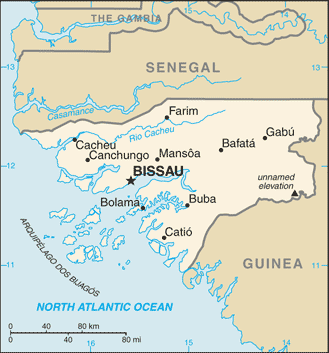Republic of Guinea-Bissau
POPULATION: 1.801 million (2014)
AREA: 13,948 sq. mi. (36,125 sq. km)
LANGUAGES: Portuguese (official); Crioulo, Balante, Fula, Malinke
NATIONAL CURRENCY: Guinea peso
PRINCIPAL RELIGIONS: Traditional 50%, Muslim 45%, Christian 5%
CITIES: Bissau (capital), 233,000 (1995 est.); Bafata, Bissora, Bolama, Cacheu, Teixeira Pinto, Farim, Gabu, Mansoa
ANNUAL RAINFALL: Varies from 49 in. (1,250 mm) in the northeast to 108 in. (2,750 mm) along the southern coast.
ECONOMY: GDP $1.022 billion (2014)
PRINCIPAL PRODUCTS AND EXPORTS:
- Agricultural: cashews, palm kernels, rice, cassava, beans, corn, fish, cotton, forest products Manufacturing: beer brewing, beverage processing (including fruit juices), agricultural processing
- Mining: bauxite, phosphates, oil
GOVERNMENT: Independence from Portugal, 1974. President elected by universal suffrage. Governing bodies: Assembleia Nacional Popular (National Popular Assembly), also directly elected; Council of Ministers and Prime Minister, appointed by the president.
HEADS OF STATE SINCE INDEPENDENCE:
- 1974–1980 President LuIz Cabral
- 1980–1999 President Joao Bernardo Vieira
- 1999– President Malam Bacai Sanha
ARMED FORCES: 7,300 (1998 est.)
EDUCATION: Compulsory for ages 7–13; literacy rate 55%

Guinea-Bissau, located on Africa's Atlantic Coast, is one of the poorest countries in the world. Since winning its independence from Portugal in 1974, the country has been torn by political rivalries and ethnic tensions that have devastated its economy.
GEOGRAPHY AND PEOPLES
The most striking feature of Guinea-Bissau's geography is the great number of watercourses that run through the small nation. Many large tidal estuaries break up the coast, and swamps extend deep into the country's interior. Inland, the flat, low-lying terrain is covered with dense tropical rain forests. Toward the southeast, the forest gives way to savanna woodlands and to the foothills of mountains. The country's climate is tropical, with high temperatures and humidity and a single rainy season.
Over 30 ethnic groups live in Guinea-Bissau. The Balanta, who make up about one third of the population, are the nation's major rice producers. Other important ethnic groups include the FULANI, Manjaco, and Mandinka. Unlike their mostly Muslim neighbors in Senegal and Guinea, most Guinea-Bissauans practice indigenous African religions. The country's spirit shrines attract pilgrims from nations throughout West Africa.
HISTORY, GOVERNMENT, AND ECONOMY
In the mid-1400s the Portuguese became the first Europeans to visit the area that is now Guinea-Bissau. They used the region as a source of slaves for their colonies in Brazil and CAPE VERDE, a group of islands off the coast of SENEGAL. For several centuries Portugal managed the Guinea-Bissau area as part of Cape Verde. This arrangement led to a history of tense relations between Guinea-Bissauans and Cape Verdeans. When Guinea-Bissau became a separate Portuguese colony in 1879, its government was dominated by mixed-race settlers from Cape Verde who had adopted European customs and the Portuguese language.
Although the Cape Verdeans in Guinea-Bissau enjoyed numerous advantages, a group of them led the colony's struggle for independence. From 1961 until 1973, AmIlcar CABRAL and the African Independence Party of Guinea and Cape Verde (PAIGC) waged a guerrilla war against the colonial authorities. Finally in 1974, Portugal declared Guinea-Bissau an independent nation. Cabral had been assassinated in 1973, and his brother LuIs, the new leader of the PAIGC, became Guinea-Bissau's first president.
The war ruined much of Guinea-Bissau's already weak economy, and ethnic tensions added to the new nation's instability. Many Guinea-Bissauans resented the Cape Verdean influence in the PAIGC. In 1980 Luis Cabral was overthrown in a coup. Former vice president Joao Vieira took control of both the country and the PAIGC, which remained the only political party. In 1985 unrest among the nation's largest ethnic group, the Balanta, led to an attempted coup. In the early 1990s Vieira agreed to hold multiparty elections. He was reelected president and the PAIGC again won control of the national assembly. However, Vieira faced frequent political struggles within his own party and with opposition parties.
In 1998 Vieira fired the army's chief of staff for failing to stop arms smuggling to rebels in neighboring Senegal. The army rebelled against Vieira, who then asked Guinea and Senegal to send troops to stop the uprising. Several African states negotiated a cease-fire between Vieira and his opponents. An independent investigation later placed most of the blame for the smuggling on Vieira. In 1999 another uprising chased Vieira out of the country. In elections held that year Malan Bacai Sanha was chosen as president.
Guinea-Bissau's economy is heavily dependent on agriculture, with cashews and fish being its major exports. Most of the people are engaged in subsistence farming, and rice is the main staple crop. Once an important export, rice crops have been drastically reduced by war and drought and can no longer support the country's population. Guinea-Bissau has very little manufacturing and no mining, although resources of oil, phosphates, and bauxite have been discovered. (See also Colonialism in Africa, Independence Movements.)